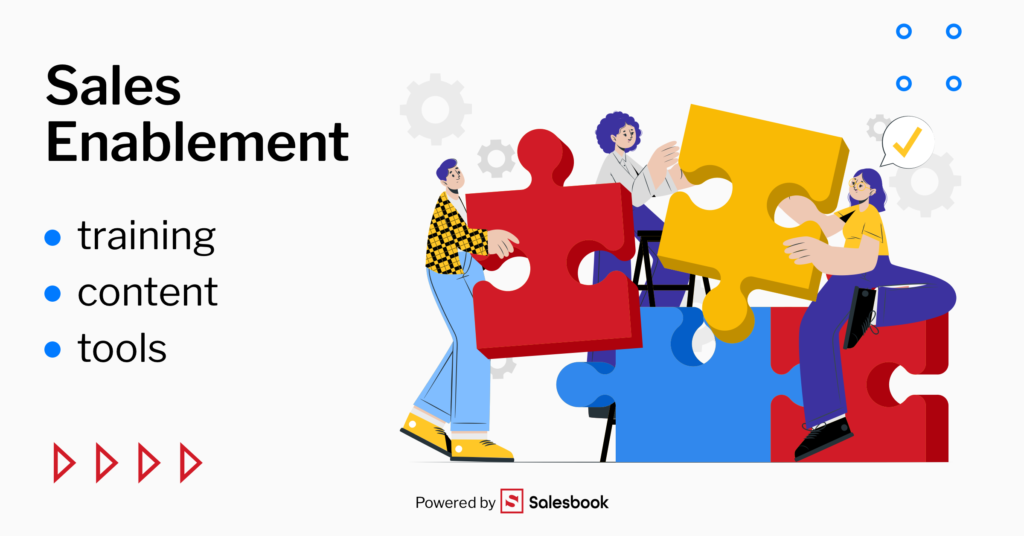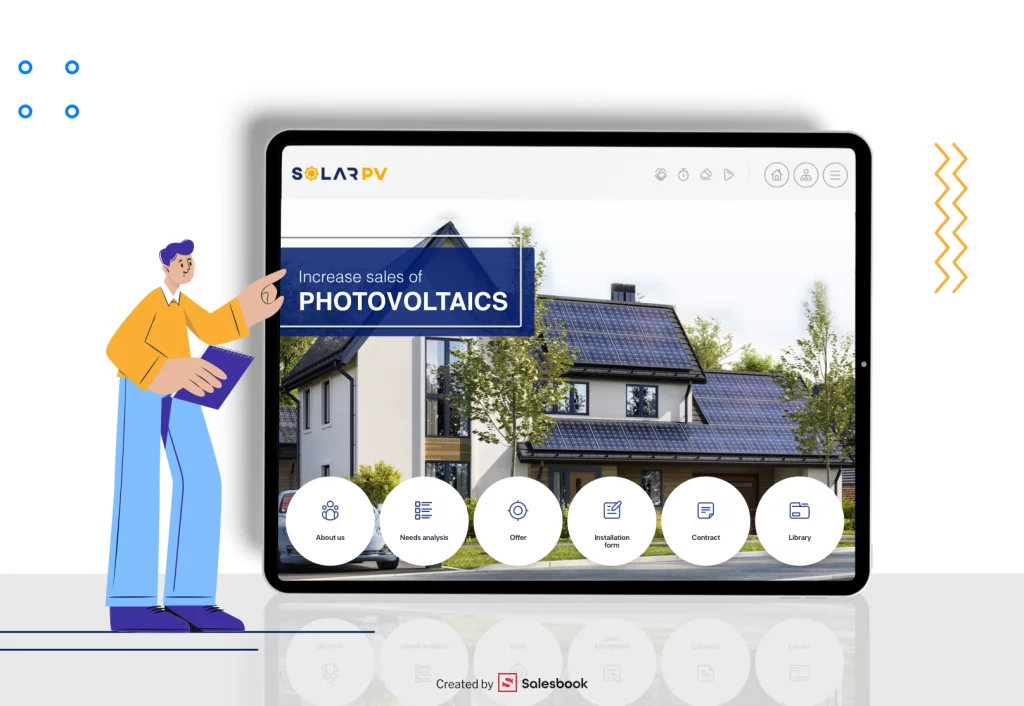Sales automation – what is it and why should you start using it today?

You’ve got a great product, an energetic team, and ambitious sales goals… and yet, the results just aren’t where they should be. New clients aren’t lining up.
So what’s the real issue?
Chances are, the problem isn’t your people – it’s your processes.
If your sales team is drowning in repetitive admin tasks and manually entering customer data instead of actually selling, you’re not just wasting time – you’re losing money.
Sales automation is the key to unlocking your team’s full potential, reaching more qualified leads, and scaling your sales without drowning in paperwork. But how exactly does it work – and is it really worth the effort?
Let’s dive in.
Is Sales Automation a Must-Have?
Imagine waking up each day and starting work with a never-ending list of repetitive tasks: filling out the same forms, answering the same questions, manually logging customer data into your CRM, and chasing down lead statuses like a detective lost in a maze of spreadsheets.
Sounds like a nightmare?
For many sales reps, it’s the reality – stuck in outdated sales processes that run on autopilot.
Now picture an alternative.
Instead of getting bogged down by routine admin, your team receives qualified leads on a silver platter, conversation scripts are ready to go, and reports generate themselves. Your salespeople get to do what they’re best at – sell – instead of playing the role of a glorified assistant.
That’s the power of sales automation. It’s not about replacing people with machines – it’s about freeing up your talent to focus on the work that actually drives revenue.
Still wondering if it’s really necessary?
Then ask yourself this: would you rather wait in line at the post office to send invoices – or hit “Send” and move on?
In the next section, we’ll explore how sales automation reduces customer service costs, streamlines lead generation, and simplifies reporting – all without the busywork.

What Is Sales Automation, Really?
Picture this: you run a restaurant. Your chefs are brilliant – but instead of cooking, they spend hours chopping vegetables, doing the dishes, and answering the phone to take reservations. Sounds ridiculous, right?
And yet… that’s exactly what’s happening in many sales departments.
Top-performing reps waste precious hours entering customer data by hand, digging through unqualified leads, and handling repetitive tasks – instead of doing what actually drives revenue: closing deals.
So, what is sales automation?
Sales automation is the process of offloading repetitive, manual tasks – like lead assignment, quote sending, follow-ups, or generating reports – to dedicated automation tools instead of your sales team.
The result? Your team sells more, sells faster, and sells smarter.
Why Does Sales Automation Matter?
Here’s what you really gain:
- Time savings – No more spending hours manually inputting leads. Reps focus on conversations and conversions.
- Lower customer acquisition cost – Fewer people managing the same process means lower operational costs.
- Smarter lead usage – Automated reminders, customer segmentation, and personalized messaging increase conversion rates.
- Faster decisions – With real-time sales reports, managers base strategy on hard data, not gut feeling.
- No more chaos – CRM systems pull all your data into one place, eliminating lost leads and messy communication.
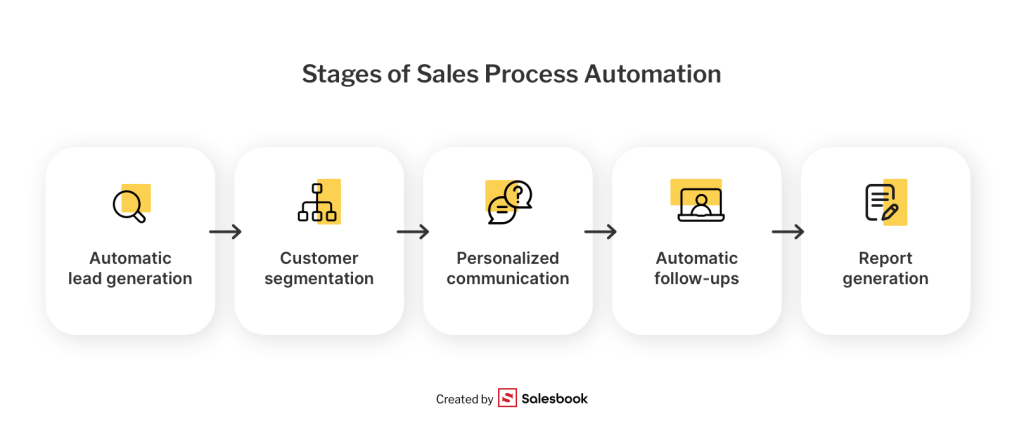
Key Areas Where Sales Automation Supercharges Your Results
Selling without automation is like entering a Formula 1 race… on foot. You might have a talented team, bold targets, and all the energy in the world — but if you’re relying on manual processes, you’re not racing to the finish line — you’re trailing far behind the competition.
Now imagine switching gears and stepping into a Formula 1 car: with real-time data, a streamlined system, and a strategy built for speed. That’s what sales automation brings to the table.
Let’s take a closer look at the areas of your sales process that can go full throttle — and how it directly impacts your bottom line.
Lead Generation and Qualification
You could manually scroll through contact lists, send cold emails, and hope someone bites. Or you could let a sales automation system do the heavy lifting.
Modern tools can automatically capture leads from multiple sources — your website, ad campaigns, social media, webinars, and more. That means your team no longer wastes time chasing long shots. Instead, they focus on leads who are already showing interest in what you offer.
But that’s just the beginning. Smart CRMs can assign leads to the right sales reps based on experience, territory, or industry. And when the right rep engages the right prospect at the right time — your close rate shoots up.
Most importantly, sales automation slashes response time. Did you know companies that respond to a lead within 5 minutes are 21 times more likely to close the deal compared to those that take 30 minutes?
(Source: Lead Response Management Study)
With automation in place, your CRM instantly routes the lead, triggers a personalized message, and puts your sales team in pole position — while your competitors are still fumbling with spreadsheets.

Lowering Customer Service Costs with Automation Tools
Every salesperson knows the golden rule: acquiring a new customer costs five times more than retaining an existing one.
So if your goal is to maximize profit, efficiency in customer service isn’t optional — it’s essential. And this is where sales automation delivers savings that traditional methods simply can’t match.
Instead of wasting time manually replying to the same questions, you can implement automated reminders, chatbots, or email sequences that guide your customers through every stage of the sales process.
And when your team uses a sales automation platform, support tickets or inquiries are automatically routed to the right person — so no customer is left waiting in limbo.
But that’s not the only way automation cuts service costs.
It also reduces the need to hire more staff for repetitive tasks. As your customer base grows, your team doesn’t have to grow at the same pace. With a powerful CRM in place, you can handle more inquiries with fewer resources.
That means more closed deals, without increasing operational overhead.
Want hard numbers?
Companies that implement sales automation tools can reduce customer service costs by up to 30%, while improving satisfaction at the same time. It’s a win-win — for your team, your customers, and your bottom line (source: McKinsey & Company).
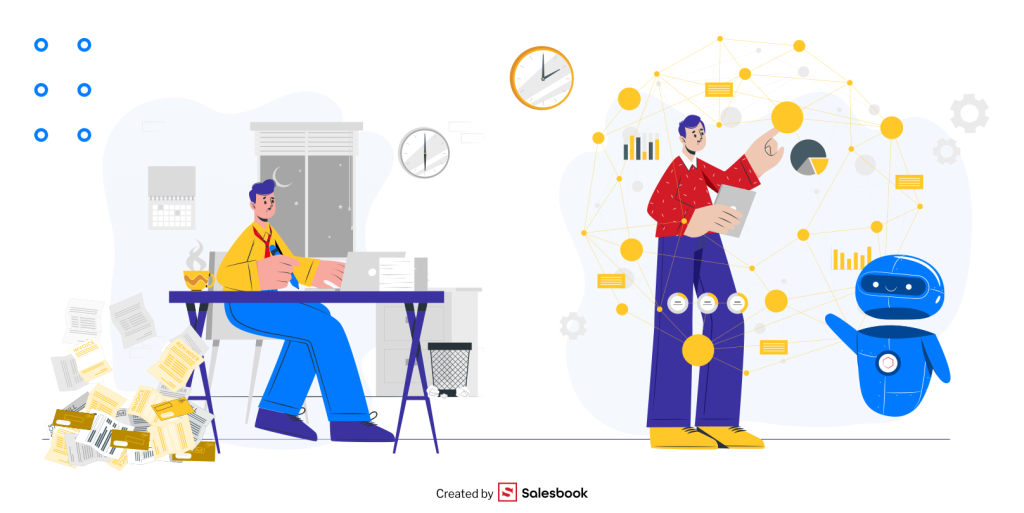
Automated Sales Reporting
Selling without analyzing your results is like playing poker with your eyes closed. Sure, you might get lucky once or twice — but sooner or later, you’re going to lose.
Sales reports aren’t just “nice-to-have” dashboards for executives — they’re mission-critical tools for making informed, strategic business decisions.
Traditionally, generating these reports meant digging through Excel sheets, manually crunching numbers, and trying to reconcile data from scattered sources. It was time-consuming, error-prone, and expensive.
Sales automation puts an end to that — delivering accurate, real-time reports without the manual grind.
What’s in it for you?
- Instant insights – No more waiting for monthly spreadsheets. Get up-to-date data whenever you need it.
- Better performance tracking – Spot what’s not working, fast — and adjust before small issues turn into lost revenue.
- Accurate forecasting – Analyze customer behavior and sales trends to make smarter investment decisions.
The result? Your sales strategy is no longer based on gut instinct — it’s powered by hard data. And when you automate reporting, you free up your team to focus on what really matters: growing revenue.
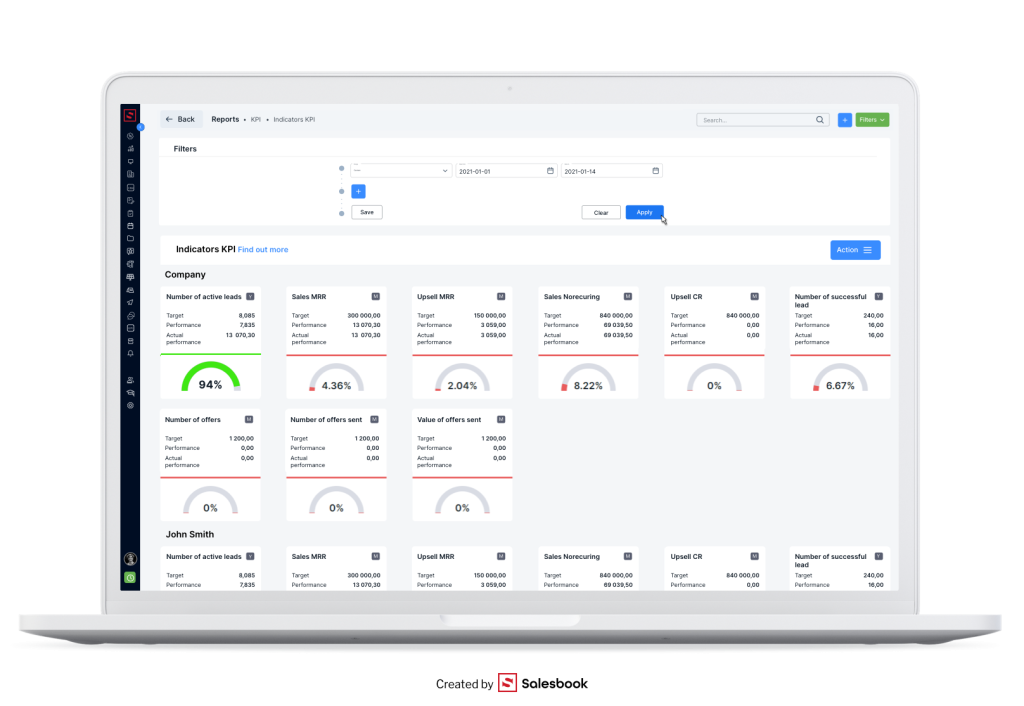
How to Implement Sales Automation in Your Company
Think of sales automation like upgrading your engine. Even the best car can go faster and run more efficiently with the right performance tweaks.
The problem? Many companies either don’t know where to start — or fear the process will be complex, expensive, and disruptive.
Here’s the good news: It’s easier than you think — as long as you take a strategic approach.
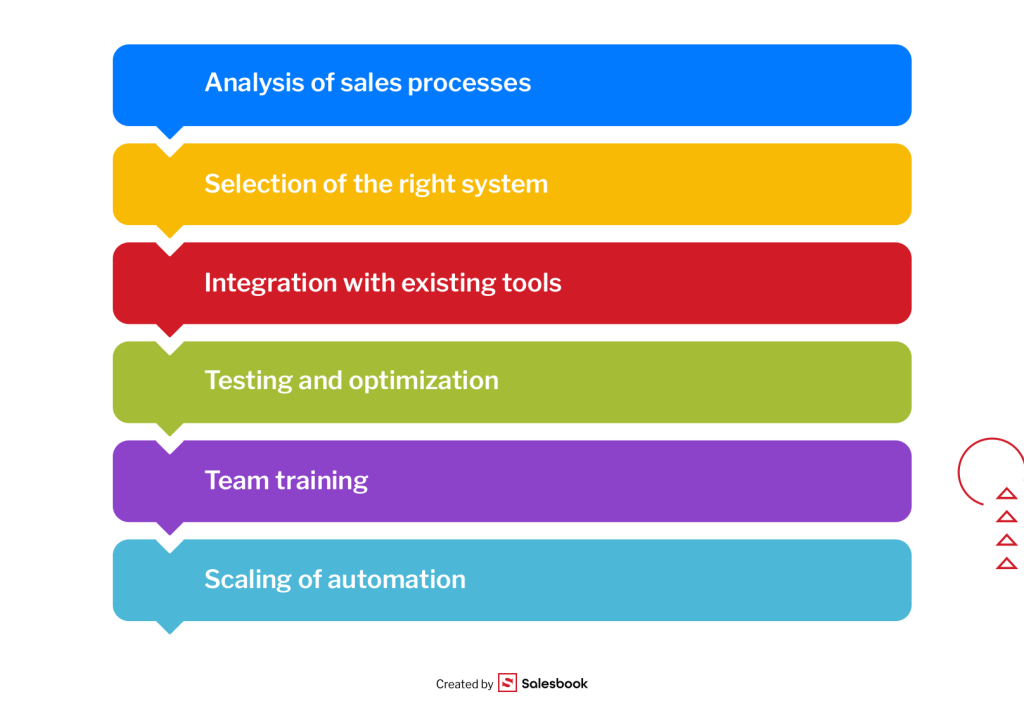
Choosing the Right Tools and Aligning Them with Your Business Needs
Not every company needs the same automation stack. Your sales automation platform should match the size of your team, the complexity of your sales process, and the specifics of your industry. When evaluating tools, pay close attention to:
- Integrations – Does the CRM connect with your existing tools (email, calls, invoicing platforms)?
- Lead routing – Who receives inbound inquiries? Is the system smart enough to assign them to the right rep?
- Personalized communication – Can you tailor messages based on customer behavior and preferences?
- Sales reporting – Can you easily analyze performance and trends?
- Scalability – Will the system grow with your business?
To avoid chaos, start by mapping your current sales processes. Identify which tasks can be automated, and which still require a human touch.
Common Pitfalls in Sales Automation – And How to Avoid Them
Implementing automation doesn’t mean everything will magically fall into place. Many companies fall into the same traps — wasting time and money.
Here’s how to sidestep them:
- No clear strategy
Automation is a tool, not a silver bullet. Without clear goals, you won’t see meaningful results.
Solution: Start small — begin with automating lead capture or follow-up emails, then expand step by step. - Overly complex tools
Some companies invest in all-in-one platforms that no one ends up using — simply because they’re too difficult to navigate.
Solution: Choose intuitive tools that are easy to adopt. Automation should boost your team’s productivity, not slow them down. - Lack of training
The best system won’t work if your sales team doesn’t know how to use it.
Solution: Invest in training. Show real-life benefits and roll out the system gradually with support along the way.
Remember: automation helps you stay organized — but it doesn’t replace good salespeople.
The key is finding the right balance between smart technology and human connection.

How to Measure Success and Scale Your Sales Automation Strategy
So how do you know if your automation setup is actually working?
Start by tracking a few key performance indicators:
- Lead response time – Is your team responding faster to inbound inquiries?
- Increase in closed deals – Is automation boosting your team’s effectiveness?
- Reduced customer service costs – Are there fewer repetitive tasks and more time for strategic work?
- Improved reporting quality – Are automated reports helping you make better, faster decisions?
Once your system is running smoothly and delivering results, it’s time to scale. Your automation strategy should grow with your business. Test new tools, add integrations, and analyze performance regularly.
The most important takeaway?
Sales automation isn’t a one-and-done project — it’s an ongoing process of optimization. The more refined it becomes, the faster your business will pull ahead of the competition.

Why Sales Automation Is More Than Just Software
You can buy the fastest car on the market — but without a skilled driver, a pit crew, and a race strategy, you’re not winning any races.
The same is true for sales automation software.
Buying powerful sales automation tools is a great first step, but unlocking the full benefits of sales automation requires a shift in mindset. The most successful companies don’t treat automation as a tech upgrade — they treat it as a cultural evolution.
When you create a sales process built around automation, your sales team members stop working harder and start working smarter. Reps no longer operate in silos or react to problems. Instead, they follow data-driven workflows that continuously improve.

Empowering Sales Reps with Automation (Without Making Them Feel Replaced)
When introducing automation, one of the biggest challenges isn’t technical — it’s emotional. Many sales reps worry that automation will make their roles redundant. The truth? Sales automation isn’t here to replace your team — it’s here to empower them. By removing repetitive tasks and streamlining the sales process, automation gives your reps more time to focus on what they do best: building relationships and closing deals.
Your Sales Team Is Not Being Replaced — It’s Being Reinforced
One common fear among sales reps is that automation will make them obsolete. In reality, automation removes the tedious parts of their job, giving them more time to do what they do best: build relationships and close deals.
Example:
A rep who used to spend 2 hours a day writing follow-up emails now uses automated sequences that trigger based on lead behavior. That time is now invested in high-value conversations — the kind that drive revenue and deepen trust.
Tip: Involve your sales team in the automation design process. Let them flag the tasks that slow them down — and turn those into automation wins.

The Role of Sales Managers in Scaling Automation
Sales managers play a critical role in making automation stick — and scale. They’re the bridge between strategy and execution, responsible for turning automation tools into real business outcomes. By using automation to eliminate manual tasks, reduce administrative tasks, and automate repetitive sales tasks, managers free their teams to focus on selling.
But the value goes beyond efficiency. With access to accurate customer data, up-to-date sales data, and a clearer sales pipeline, managers can make smarter decisions, coach more effectively, and optimize every stage of the sales funnel. Automation, when used right, transforms sales leadership from reactive to radically proactive.
Data-Driven Leadership Starts Here
For sales managers, automation provides an unprecedented level of visibility. No more guessing why performance dropped or which campaign worked. With automated dashboards and real-time tracking, every metric is available at a glance.
Sales productivity becomes measurable, scalable, and actionable.
Tip: Set KPIs that reflect automation success — like lead response time, number of qualified leads engaged per rep, or time-to-close. Use these metrics to optimize not just tools, but coaching and strategy too.
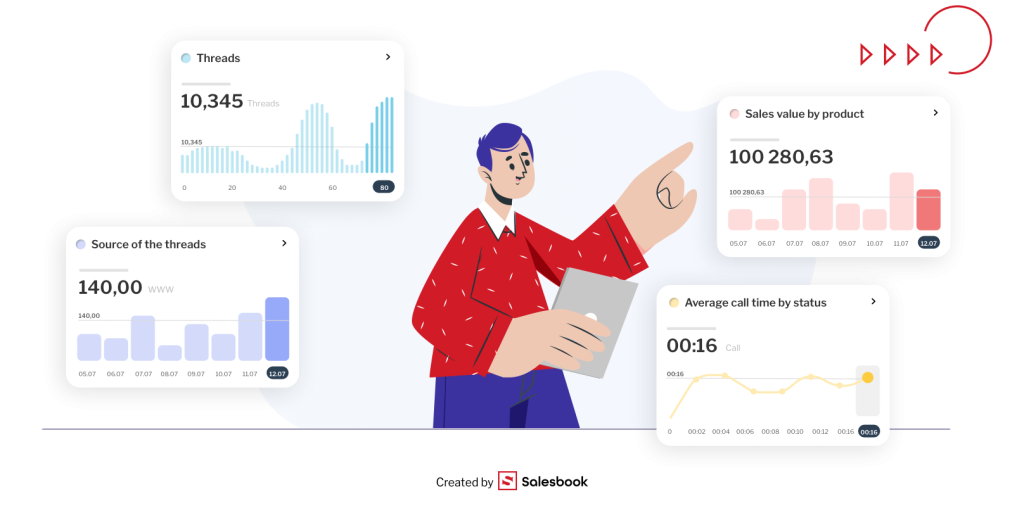
Personalization at Scale — The Holy Grail of Modern Sales
Modern buyers expect relevance — not generic pitches. But delivering tailored experiences to hundreds of leads manually? That’s impossible. With the right automation tools and smart use of customer data, your sales team can personalize outreach at scale, turning mass communication into meaningful connection — without sacrificing speed or efficiency.
Automate the Process, Not the Connection
One of the myths about sales automation is that it kills authenticity. In truth, when done right, automation enhances personalization.
By using customer data to tailor communication, your sales team can deliver highly relevant messages — without lifting a finger.
Example:
A CRM integrated with your sales automation software can trigger personalized product recommendations or renewal reminders based on a client’s activity, location, or industry.
Tip: Use dynamic fields, behavioral triggers, and segmentation rules to personalize at scale — making every prospect feel like your only prospect.

Training Your Sales Team to Thrive in an Automated Environment
To truly automate sales processes, you need more than just the right tools — you need well-equipped sales professionals. Whether they’re handling sales calls, managing the sales cycle, or using customer relationship management platforms, proper training ensures your team understands how automation fits into the entire sales process. The result? Greater confidence, smoother adoption, and ultimately — more sales.
Adoption Is Everything
Even the best sales process automation setup can fail if your team doesn’t adopt it. The biggest barrier? Lack of training and clarity.
Tip: Treat automation onboarding like product onboarding. Provide micro-trainings, real-world use cases, and quick wins early on to build confidence. Assign automation champions among sales team members to foster peer learning.
Also, be transparent about the benefits of sales automation. When reps see how automation makes their lives easier, adoption becomes inevitable.
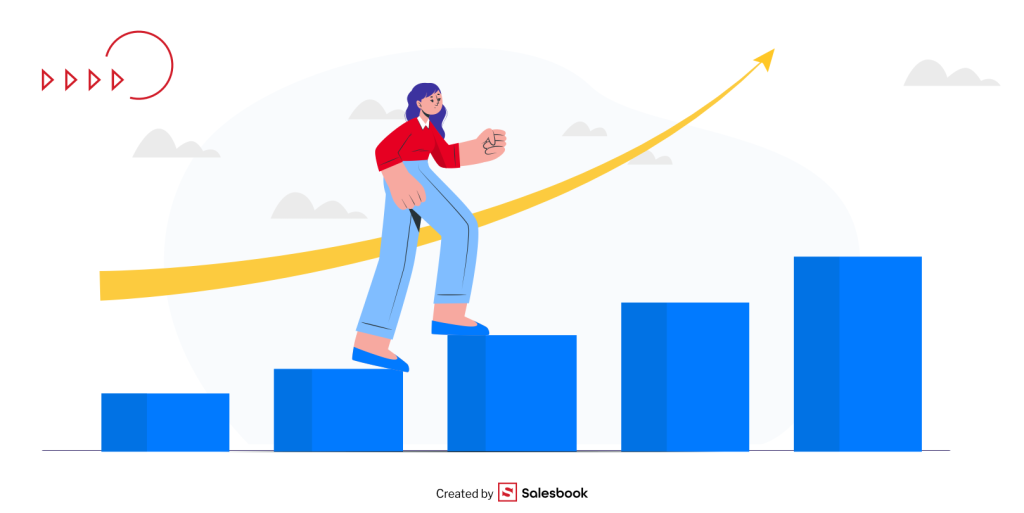
The Compound Effect — Why Small Automations Lead to Massive Growth
Sales automation doesn’t have to start big to make a big impact. Small improvements — like automating simple sales tasks or cutting down on administrative tasks — can create momentum that transforms your entire sales funnel. Over time, these efficiencies compound, accelerating your sales pipeline and driving consistent, scalable growth.
Sales Automation Is a Long Game
Don’t try to automate everything overnight. Instead, start with the highest-friction points in your sales process — like lead qualification, email follow-ups, or task assignments.
As your team adjusts, layer in more sophisticated workflows. Each improvement compounds over time, creating a flywheel of sales productivity and efficiency.
Example:
A mid-sized SaaS company started by automating lead routing and follow-ups. Six months later, they implemented automated onboarding flows, deal scoring, and churn prediction alerts. The result? A 40% boost in pipeline velocity and a 25% drop in customer acquisition cost.
Tip: Revisit your automation stack quarterly. Test new tools, eliminate redundancies, and continue aligning automation with your sales goals.
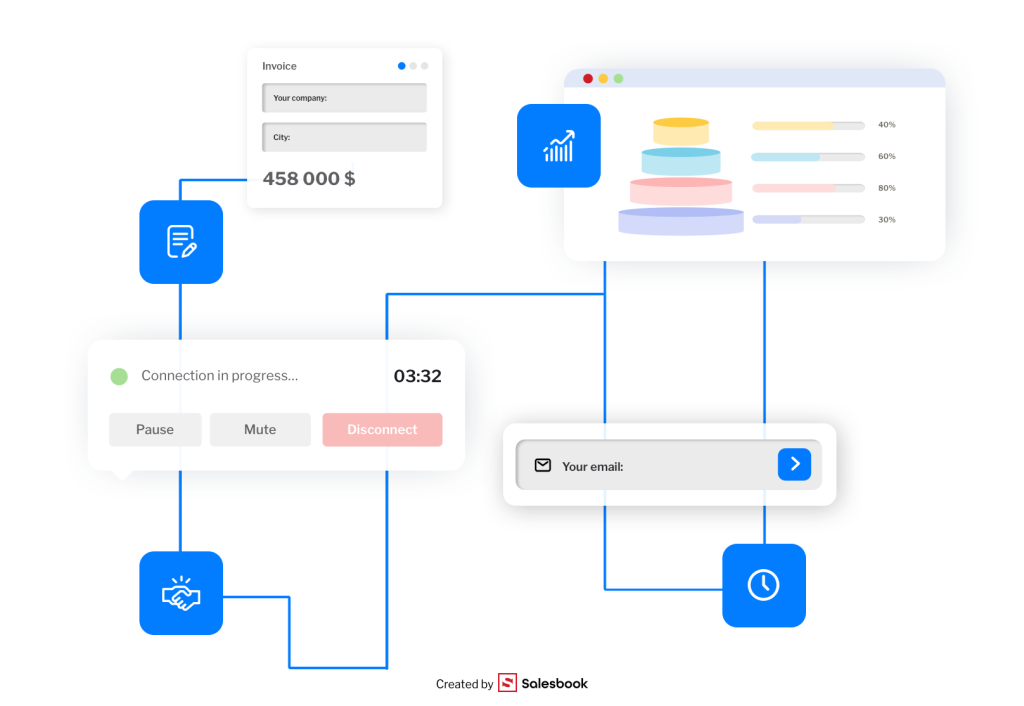
How Does Salesbook Support Sales Automation?
Want your team to focus on selling — not drowning in admin work? Salesbook does the heavy lifting for you.
Here’s how:
- Interactive and intelligent customer needs analysis
Forget scripted questions. Sales reps lead dynamic, data-driven conversations that dramatically boost close rates. - Leads go to the right reps — automatically
No delays. No chaos. Just instant, intelligent lead routing. - Instant offer generation and real-time reporting
Make decisions based on solid data, not gut feelings.
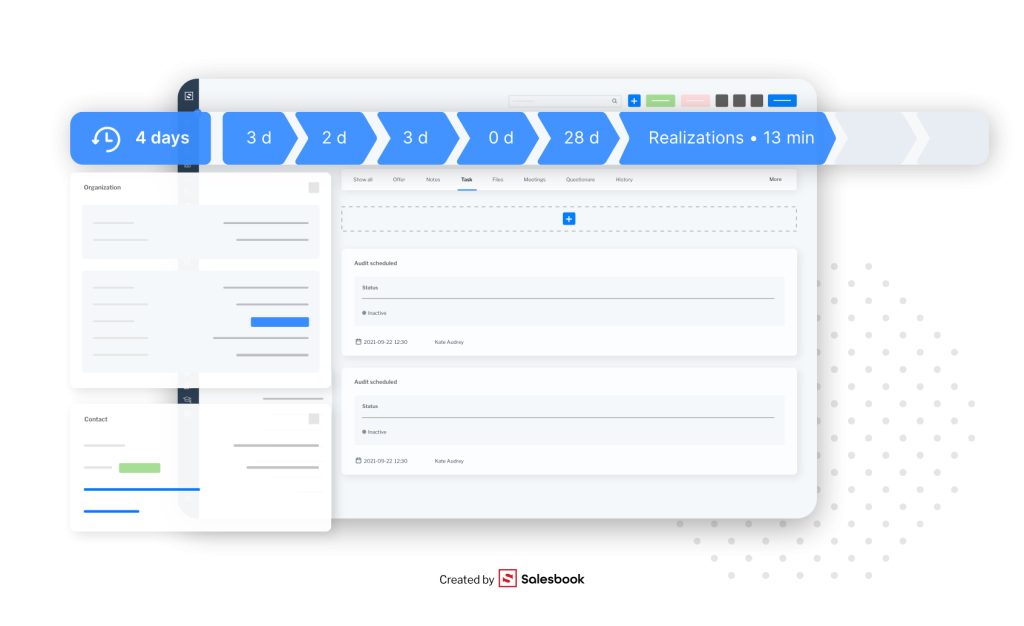
- No errors or duplicates
All your data is synced across the system in real time. - Automated follow-ups and personalized messaging
Prospects receive the right message at the right time — increasing engagement and conversion.
The result?
Higher effectiveness, lower customer service costs, and a sales process that runs like a well-oiled machine.
Still not convinced? Book your free Salesbook demo here and see it in action.

Sales Automation Software: A Must-Have in Modern Business
Selling without automation is like racing a bicycle against a Formula 1 car. You might give it your all — but competitors with the right tools will always be one step ahead. And winning over customers? That becomes a painful uphill battle.
With sales automation, your team no longer wastes time on repetitive tasks, manual data entry, or messy follow-ups.
A smart automation system helps you boost efficiency, lower customer service costs, and make strategic business decisions based on real-time data.
Ready to leave the competition in the dust?
See how Salesbook can transform your sales process — and start gaining an edge today.
Table of Contents


